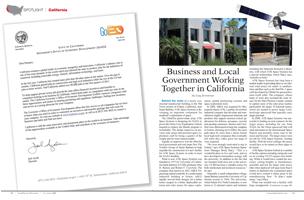
 Behind the walls of a newly constructed nondescript building in the Old Town section of Goleta, California, near Santa Barbara, ATK Space Systems is developing an important component for mankind’s exploration of space.
Behind the walls of a newly constructed nondescript building in the Old Town section of Goleta, California, near Santa Barbara, ATK Space Systems is developing an important component for mankind’s exploration of space.
The UltraFlex photovoltaic array ATK Space Systems is designing for NASA to power the Orion Crew Exploration Vehicle targeted to replace the Shuttle program is remarkable. The design improves on previous solar arrays that powered space exploration craft by being a quarter of the weight and far more maneuverable.
Equally as impressive was the effort by local government and real estate firm The Towbes Group of Santa Barbara to help expedite the construction of a new facility for ATK Space Systems in order to meet the NASA deadline.
What is now ATK Space Systems was founded in 1975 by University of California Santa Barbara (UCSB) graduates Max D. Benton and Robert F. Crawford. The company then known as AEC-ABLE Engineering started modestly in a multi-tenant industrial building in Goleta. ABLE rapidly moved from designs for a better tennis racquet to a better deployable antenna and solar arrays for space exploration, global positioning systems and space exploration tools.
In 2004, ABLE was acquired by Minneapolis-based ATK, a global, diversified, industrial company that develops and manufactures highly-engineered materials and products that support mission-critical applications for defense, aerospace, security and sporting customers. Benton and Crawford were determined to keep the company in Goleta, choosing not to follow the same path taken by more than a dozen former local high-tech companies that eventually left when they either grew too large or were acquired.
“We were strongly motivated to stay in Goleta,” says ATK Space Systems Operations Manager Brian Macy. “This is a wonderful place to live and work, and we have developed a tremendous synergy with the university. In addition to the fact that our founders held close ties to the university, UCSB has been a valuable source for both intellectual and technical resources,” he says.
Originally a small independent college, Santa Barbara joined the University of California system in 1944. The university, which boasts five Nobel Laureates, is now home to 12 national centers and institutes including the Materials Research Laboratory, with which ATK Space Systems has a special relationship, which Macy says, “benefits us both.”
ATK Space Systems has long been a market leader in providing three to six kilowatt solar arrays for small- to medium-class satellites such as the StarTM- 2 space craft developed by Orbital for geosynchronous Earth orbit. The company, whose body of work also included the solar arrays for the Mars Phoenix Lander, wanted to capture more of the solar array market, particularly the larger 10 kilowatt arrays, which are needed to power larger Lockheed-type spacecraft that typically carry larger payload.
In 2008, ATK Space Systems was successful in landing several contracts for the larger arrays, including the one from NASA for the Orion  spacecraft that will send astronauts to the International Space Station and possibly return man to the moon and beyond. The larger arrays were too tall for ATK Space Systems’ existing facility. With the lower ceilings, the arrays would have to be turned on their edges to be tested.
spacecraft that will send astronauts to the International Space Station and possibly return man to the moon and beyond. The larger arrays were too tall for ATK Space Systems’ existing facility. With the lower ceilings, the arrays would have to be turned on their edges to be tested.
ATK Space Systems looked at a number of facility options including raising the roof on its existing 59,535-square-foot building. While it would have created the necessary ceiling heights to manufacture, assemble and test the larger solar arrays (that when deployed will span more than 6 meters in diameter) the constrained space would have created a choke point in the manufacturing flow. “It didn’t make sense,” says Macy.
What was needed was a facility with large unsupported floor space, and there were few if any options in Goleta. And the facility issue needed to be addressed quickly or ATK Space Systems would either have to find a segregated site to handle the job or be in jeopardy of losing the NASA contract. Neither option was acceptable.
In 2008, The Towbes Group acquired the 4.6 acre property on which ATK Space Systems’ building sat. The acquisition came at an opportune time for ATK, which had been unsuccessful in exploring the possibility of expansion with the former landlord and was in the process looking at other sites outside of Goleta.
The Towbes Group, a fully integrated real estate investment, development and property management company, had a proven track record in Goleta. With more than 750,000 square feet of commercial, industrial and retail space in a city that has historically taken its time with new development, Towbes had collateral behind its promise to deliver an expansion project for ATK Space Systems.
The ATK Space Systems project became a case study of successful cooperation between business and local government. Local officials decided to prioritize a building expansion for a valued local business, with the redevelopment agency advocating on ATK’s behalf and facilitating the process.
“Revitalizing a project area involves collaboration between residents, business and local government,” says Vyto Adomaitis, the city’s director of redevelopment, neighborhood services and public safety. The city embraces the idea of retaining and attracting jobs, especially clean tech jobs. California’s redevelopment agencies—currently faced with elimination in the Governor’s proposed budget—he adds, “are one of the last remaining tools in the state to create investment opportunities, create and retain needed jobs and improve the community.”
The company reached out to city officials for support. “We were given a tour, and we were shown the incredible things they were producing,” says Mayor Margaret Connell, who was a city councilperson at the time. “We needed to do everything we could to keep them in Goleta,” she recalls.
“We were pleasantly surprised with Goleta’s response to Towbes development plans for our expansion,” says Macy.
When facing a challenging process that takes time and money, “businesses may be willing to go through the process, but they want certainty of results and often seek assistance through officials charged with encouraging economic development,” says Adomaitis. “They often benefit from having advocates to get them through the process and into the end zone and we were happy to play that role.”
However, reaching pay dirt wasn’t an easy task. Expansion plans on the property were handcuffed by a number of complicated matters including issues related to the setbacks and right-of-way associated with moving planned road to the edge of a nearby wetland.
“It was critically important that we do whatever we could without violating sound governmental principles and environment protection,” says Mayor Connell.
Probably the most remarkable accommodation by the city, arguably, was the relocation of Ekwill Road, an important connector road through Goleta’s industrial area. In the planning stages for decades, the road would have bifurcated the ATK Space Systems property, making expansion all but impossible for the aerospace contractor. The development team was able to demonstrate to the city that the placement of the street was problematic, and that by moving the road north of the site would create a more valuable development opportunity for the city.
However, in order to relocate the road north near the lip of the San Jose Creek, creek setbacks from the road needed to be reset. To do so required the monumental task of changing general plan policies.
These variances were made in part because of the beneficial nature of the project to the city, according to Mayor Connell. Under the so-called good cause findings, the general plan could be changed, if it was shown to provide a public benefit. Since then, the setbacks have been made more flexible in the general plan.
As part of the project, millions of dollars also were spent on creek restoration and protection from storm water run-off. Improvements included a series of bio swales, retention basins and carbon filter recycling on the ATK site. The net result is less storm water runoff than before the development of the new facility.
The effort was an unprecedented one for this small city of 31,000 people. With the three-way coordination among ATK Space Systems, The Towbes Group and Goleta city officials, the company reached the end zone as the clock was ticking down.
 On August 19, 2010, less than a year after breaking ground on an empty plot of land at 600 Pine Avenue in Old Town Goleta, ATK Space Systems cut the ribbon on its new 25,000-square-foot building. In addition to a new manufacturing area with 30-foot clear heights to accommodate the size of the larger solar arrays, and a maneuverable overhead crane, the building also includes a new laboratory, clean room, office and conference space.
On August 19, 2010, less than a year after breaking ground on an empty plot of land at 600 Pine Avenue in Old Town Goleta, ATK Space Systems cut the ribbon on its new 25,000-square-foot building. In addition to a new manufacturing area with 30-foot clear heights to accommodate the size of the larger solar arrays, and a maneuverable overhead crane, the building also includes a new laboratory, clean room, office and conference space.
The Towbes Group, for its part, was able to design and complete a world class facility in only 10 months -- fast enough for ATK Space Systems to meet its customers’ tight schedules, and to keep 170 high-paying jobs and countless future ones in the city. For the city, it successfully put its flag on a building to show they want to keep companies like ATK Space Systems, where they belong in Goleta.
In the end, “this was a victory for ATK Space Systems, the community, the city and the state,” says Adomaitis.
In the near future, solar arrays made by ATK Space Systems will be soaring across the solar system. The company that made those arrays, however, will be staying earthbound --in Goleta.

